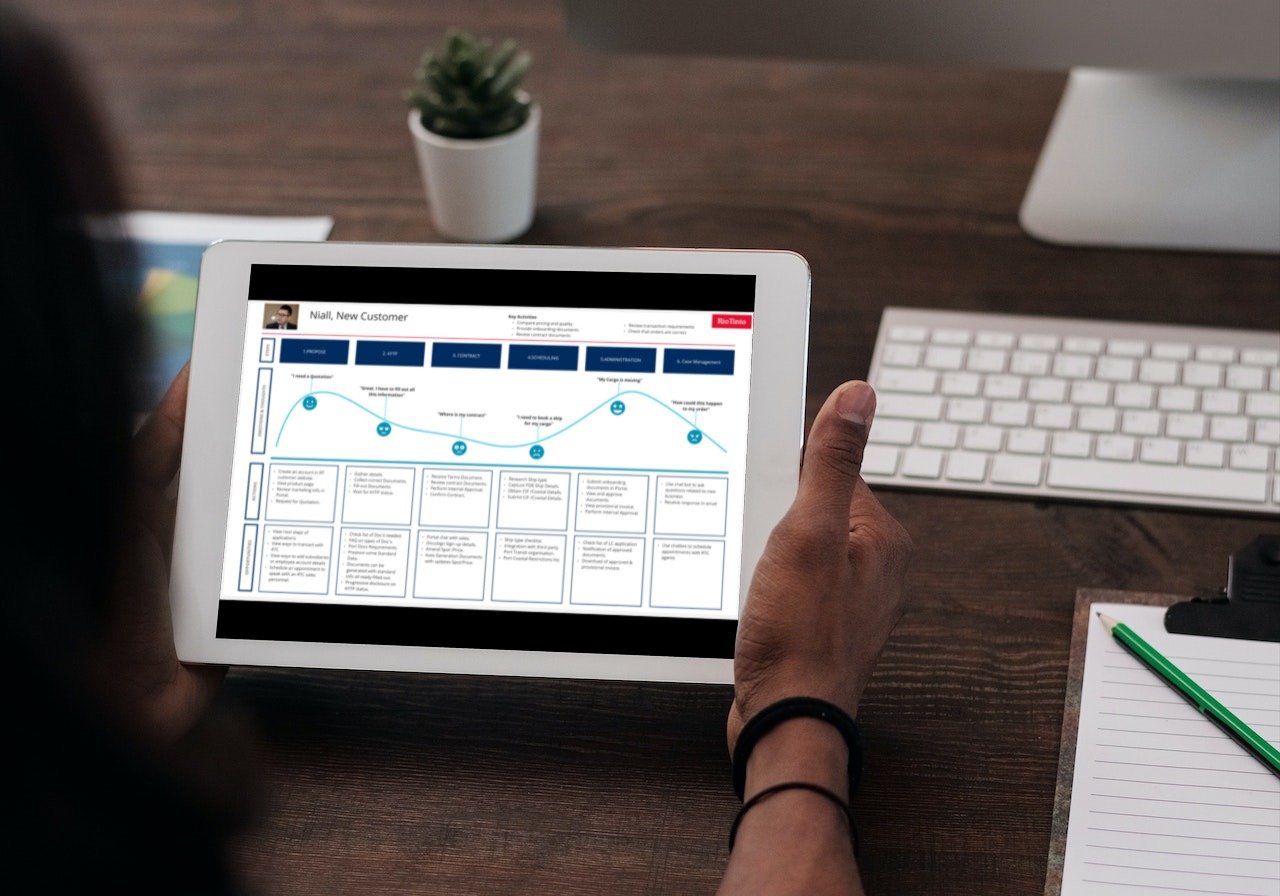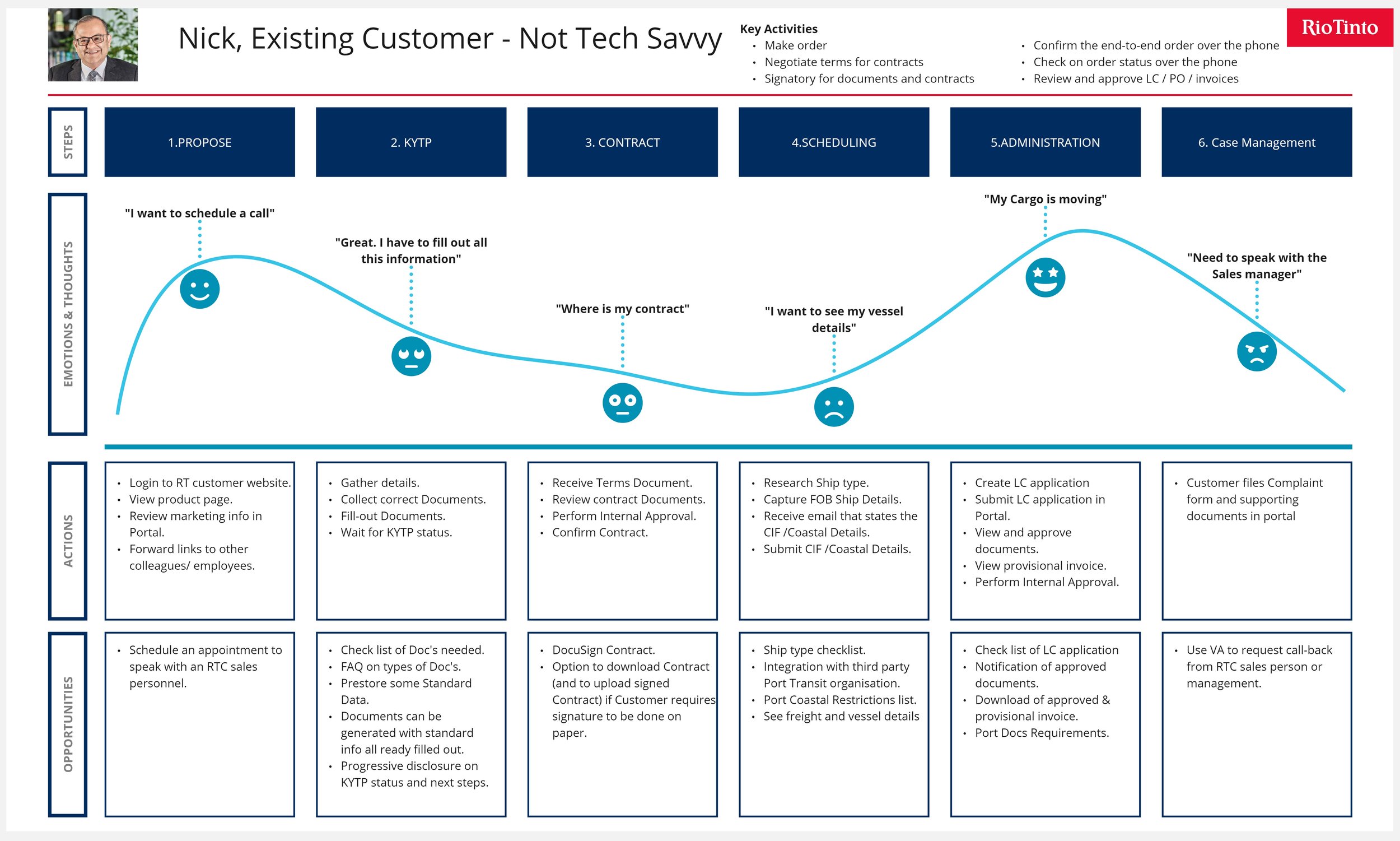Rio Tinto
Personas & Customer Journey
-
Introduction
Brief: Map customer journeys and build personas to guide a user-centered portal redesign for all global teams.
Challenge: Users struggled with confusing flows and forms; teams needed clarity on user needs.
Goals: Make the portals intuitive, improve engagement, and align features with real user goals.
-
Discovery Phase
Stakeholder interviews: Met with product team and customer support.
Business requirements: Reduce support requests, speed up onboarding, and boost satisfaction.
User needs assessment: Users want simple forms, clear steps, and transparency on status.
-
Problem Framing
Problem statement: Users get lost in complex journeys and drop off before completing tasks.
Success criteria: Users complete core flows with fewer errors and less confusion.
Constraints & assumptions: Must work for a range of user types; legacy backend limits some changes.
-
User Research
User interviews: Gathered pain points around forms, navigation, and unclear processes.
Competitive analysis: Most portals still overlook journey mapping and persona-driven features.
Market research findings: Simpler flows and tailored content drive engagement.
-
Synthesis
User personas: “The Busy Buyer,” “The New Customer,” and “The Data Checker.”
Journey mapping: Visualized step-by-step experiences—flagged friction at onboarding and form completion.
Key insights & opportunities: Users want progress feedback, fewer steps, and more relevant info.
-
Solution Development
Information architecture: Reworked dashboard and forms based on journey maps.
Wireframes & prototypes: Designed new flows, clearer forms, and dashboard updates.
Visual design system: Clean, modern UI—easy to scan, with clear status and help cues.
-
Testing
Usability testing: Ran with key personas—flagged unclear form fields and drop-off points.
User feedback: Simplified forms, added progress indicators, and clarified next steps.
Design iterations: Tweaked flows and visuals for speed and clarity.
-
Implementation
Handoff: Annotated wireframes and personas shared with dev team.
Dev collab: Weekly syncs to keep flows user-friendly and on brand.
Go-to-market: Rolled out with onboarding tips and in-app guides.
-
Results & Impact
Metrics & KPIs: Higher completion rates, fewer support tickets, and better user feedback.
User adoption: More users finished onboarding and core flows.
Business impact: Lower support costs, higher satisfaction, and a more user-centered product.
Lessons learned: Start with real journeys, test with real users—small tweaks make a big difference.
I had been asked to create a set of Customer Journeys for existing customer portal’s within Rio Tinto Commercial, to be rolled out to teams globally. With a keen focus on understanding the users' needs and behaviors, The user journey’s were crafted showing a step-by-step experiences, ensuring that each touchpoint resonated with convenience and value. This undertaking involved a high level of empathy but also presented an opportunity to foster meaningful interactions between the users and the portal, shaping a seamless and delightful journey for each customer.
Research
This research initiative was extended to encompass a comprehensive redesign of the customer dashboard, incorporating intuitive and user-friendly forms that will require completion. As part of this extension, a meticulous set of wireframes was meticulously crafted to visually depict the enhanced user journey, derived from the insightful findings of the initial user journey analysis.
Personas
The process began with the development of detailed user personas, serving as invaluable tools to provide the teams with comprehensive insights into the diverse goals, values, needs, and responsibilities of the users.







